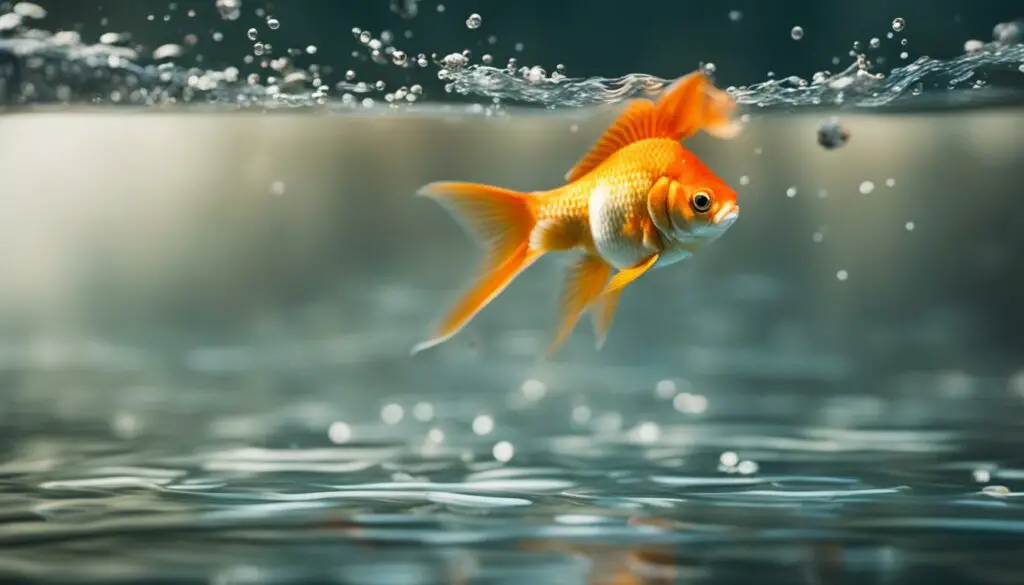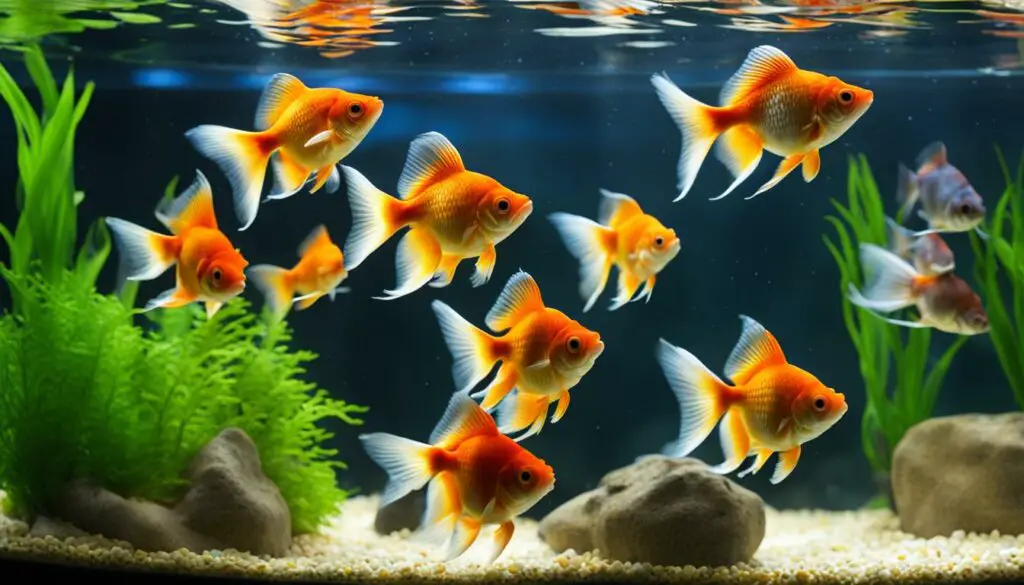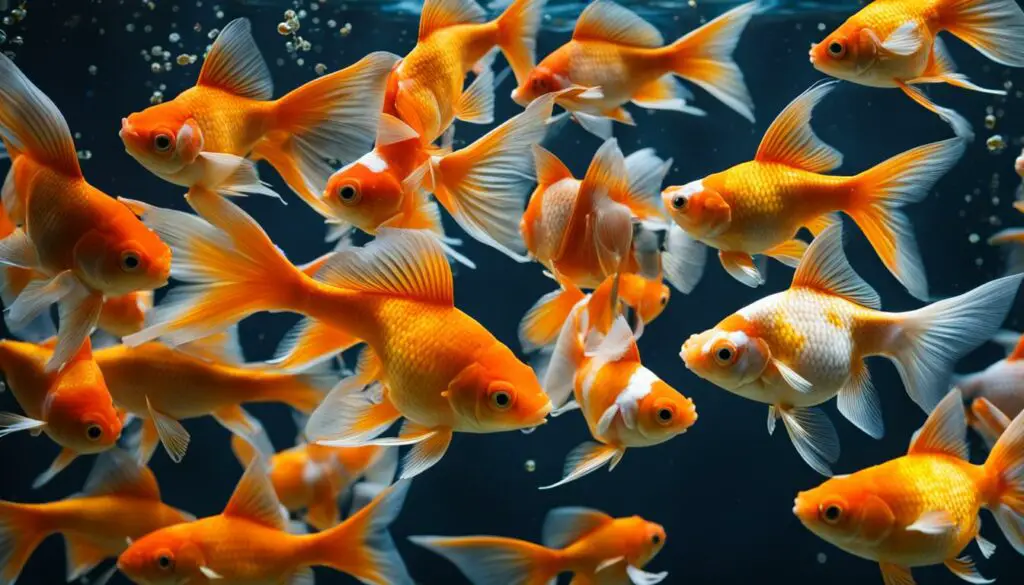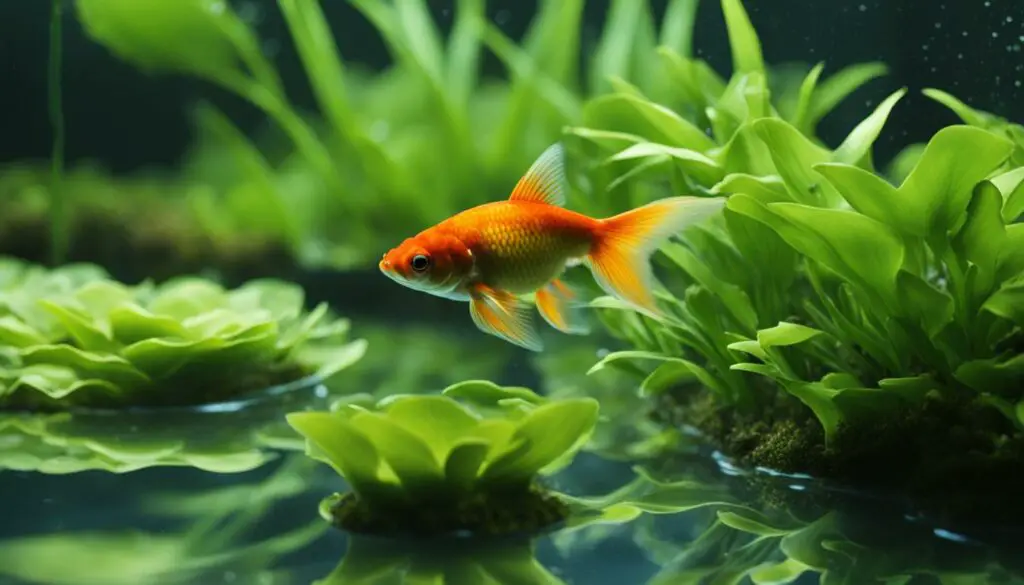Last Updated on 2 years by admin
Fancy goldfish are often considered as low maintenance and beginner-friendly pets. However, there are many myths surrounding their care and suitability as pets. In this article, we will debunk these common misconceptions and explore the reality of keeping fancy goldfish. From their memory span to their ideal living conditions and dietary needs, we will provide comprehensive information to help you understand the truth behind caring for fancy goldfish.
Key Takeaways:
- Fancy goldfish are not as low maintenance as commonly believed.
- Goldfish can remember their owners and learn tricks.
- They require spacious tanks for proper living conditions.
- Goldfish have the potential to live for more than ten years.
- They need a balanced diet of both plant and animal matter.
Do Fancy Goldfish Have a Short Memory?

One of the most common myths surrounding fancy goldfish is that they have a short memory span, often believed to be just three seconds. However, research has shown that this couldn’t be further from the truth.
Studies have revealed that fancy goldfish can actually hold memories for up to five months, showcasing their intelligence and cognitive abilities. They are capable of remembering their owners, recognizing routines, and even learning tricks. While their memory capacity may not be on par with humans, it is clear that fancy goldfish are far from forgetful.
Research has shown that fancy goldfish can actually hold memories for up to five months, showcasing their intelligence and cognitive abilities.
It’s important to understand that fancy goldfish are not just mindless creatures swimming in a bowl. They have the capacity to learn and retain information over an extended period of time. This intelligence adds an extra layer of interaction and companionship between goldfish and their owners, making them fascinating pets to keep.
By debunking the myth of their short memory span, we can appreciate the true capabilities of fancy goldfish and provide them with the mental stimulation they need to thrive.
The Truth About Keeping Goldfish in Bowls

One common myth surrounding goldfish is that they can thrive in small bowls. However, this is far from the truth. Goldfish actually require a spacious and properly maintained tank to live a healthy life. Keeping them in a bowl can stunt their growth and lead to numerous health problems. Let’s explore the truth behind this misconception and understand the optimal living conditions for goldfish.
Goldfish produce a significant amount of waste, and without proper filtration and aeration, the water in a small bowl can quickly become contaminated. This can result in poor water quality, leading to stress, infections, and even death for the goldfish. In contrast, a tank provides sufficient space for the fish to swim and ensures better water quality through efficient filtration systems.
To meet the needs of goldfish, it is recommended to provide them with a minimum of 200 liters of water. This allows them to have enough space to move around and exercise, which is essential for their physical health. Alternatively, if space allows, consider keeping goldfish in a fish pond, as it provides them with an even larger and more natural environment.
Ensuring the well-being of your goldfish goes beyond just providing them with a larger living space. Regular maintenance such as water changes and tank cleaning is necessary to maintain optimal water quality. By providing the appropriate living conditions, you can help your goldfish thrive and lead a healthy and fulfilling life.
Goldfish Lifespan: Fact vs. Fiction
One of the most common misconceptions about goldfish is that they have a short lifespan. However, with proper care, goldfish have the potential to live for more than ten years. The belief that goldfish have a short lifespan often stems from their premature deaths due to unsuitable living conditions. By providing the right environment, nutrition, and regular maintenance, you can help your goldfish thrive and live a long and fulfilling life.
Contrary to popular belief, goldfish are not disposable pets that can be kept in small bowls. They require a spacious and well-maintained tank to ensure their overall health and longevity. Goldfish produce a significant amount of waste, and providing proper filtration and aeration is essential to keep the water clean and oxygenated. It is recommended to provide them with a minimum of 200 liters of water or consider keeping them in a fish pond. Keeping goldfish in a bowl can stunt their growth and lead to various health problems.
| Goldfish Lifespan | Average Lifespan | Factors Affecting Lifespan |
|---|---|---|
| Common Goldfish | 10-20 years | Water quality, diet, genetics |
| Fancy Goldfish | 10-15 years | Water quality, diet, genetics |
| Tosakin Goldfish | 10-15 years | Water quality, diet, genetics |
Each goldfish variety may have a slightly different average lifespan, but the key factors that influence their longevity remains the same. Providing clean water, a balanced diet, and selecting healthy specimens from reputable sources are crucial for ensuring the best chances of a long and healthy life for your goldfish.
Understanding the Dietary Needs of Fancy Goldfish

Proper nutrition is essential for the health and vitality of fancy goldfish. Contrary to popular belief, goldfish are not solely herbivorous creatures. They are omnivores, meaning they require a balanced diet that includes both plant and animal matter. While goldfish do enjoy nibbling on aquatic plants, it is important to provide them with protein-rich foods to meet their dietary needs.
Goldfish thrive on a varied diet that includes high-quality pellets specifically formulated for goldfish. These pellets should be the staple food, as they contain essential nutrients and vitamins necessary for their well-being. Additionally, it is beneficial to supplement their diet with live or frozen foods such as bloodworms, brine shrimps, and insect larvae. These protein-rich foods provide them with the necessary nutrients for growth and overall health.
Feeding goldfish should be done in moderation to prevent overfeeding and water pollution. A good rule of thumb is to feed them a small amount of food that they can consume in two to three minutes, two to three times a day. It is important to monitor their feeding habits and adjust the amount of food accordingly.
Remember, a well-balanced diet plays a vital role in maintaining the overall health and vibrant colors of your fancy goldfish. By providing them with a variety of nutritious foods and monitoring their feeding habits, you can ensure a happy and healthy life for your aquatic companions.
Exploring the Different Varieties of Goldfish

Goldfish come in various breeds and types, each with distinct physical characteristics. The common goldfish, Ranchu, Oranda, Bubble Eye, Telescope, and Pearlscale are just a few examples of the different goldfish varieties available. It is important to note that these varieties belong to the same species, and their appearances result from selective breeding. Understanding the differences between these varieties can help enthusiasts choose the right goldfish for their preferences.
Table: Comparative Overview of Goldfish Varieties
| Goldfish Variety | Physical Characteristics | Distinct Features |
|---|---|---|
| Common Goldfish | Long, streamlined body; single tail fin | Hardy; suitable for outdoor ponds |
| Ranchu | Round body; short tail fin | Pom-pom growth on head; prominent wen |
| Oranda | Rounded body; split tail fin | Prominent head growth; hood or wen |
| Bubble Eye | Rounded body; double tail fin | Fluid-filled sacs under the eyes |
| Telescope | Elongated body; split tail fin | Bulging, protruding eyes |
| Pearlscale | Rounded body; double tail fin | Scaly texture; shiny, metallic scales |
These varieties offer a wide range of colors, patterns, and unique features that make them captivating additions to any goldfish tank or pond. Whether you prefer the elegance of the common goldfish or the charm of the Ranchu’s pom-pom, there is a goldfish variety to suit every taste and personal preference.
The Curious History of the Tosakin Goldfish

Rare and visually captivating, the Tosakin goldfish is a unique breed that originated in Japan. Its most distinct feature is its flamboyant undivided tail, which fans out and even curls when viewed from above. This exquisite trait sets the Tosakin apart from other goldfish varieties and makes it a sought-after species among aquatic enthusiasts.
The Tosakin goldfish is considered a natural treasure of the Kochi Prefecture in Japan.
The history of the Tosakin has been filled with challenges and near extinction. During natural disasters and World War II, the breed faced a significant decline in population. It was believed to be on the brink of extinction until a dedicated hobbyist managed to save the breed from disappearing completely.
Legend has it that this passionate individual found only six Tosakin in a local restaurant and made a deal to trade a bottle of vodka for them. Through careful breeding and preservation efforts, the Tosakin goldfish was brought back from the brink of extinction and is now celebrated as a cultural treasure in Japan.
The Tosakin’s unique appearance and remarkable history make it a prized addition to any goldfish collection. Its undivided tail and graceful swimming style add elegance to any aquarium or pond. Whether you are a seasoned goldfish enthusiast or a beginner looking for a visually stunning aquatic pet, the Tosakin goldfish is sure to captivate and delight.
The Unconventional Care of Tosakin Goldfish

Tosakin goldfish are known for their unique appearance and swimming style, which require specific care considerations. Unlike other goldfish breeds, Tosakin are traditionally kept in shallow round bowls rather than tanks. These bowls are designed to be placed outside, allowing the fish to be viewed from above. The water depth should be shallow, not exceeding 20cm, to accommodate the unique swimming characteristics of Tosakin. While this traditional method may seem unconventional to many, some Tosakin keepers have also adopted modern plastic bowls or glass tanks to meet the fish’s needs.
When keeping Tosakin goldfish, it is important to maintain the water quality and temperature to ensure their well-being. Regular water changes, filtration, and monitoring of ammonia and nitrite levels are essential. It is recommended to provide gentle water flow to mimic their natural habitat and prevent stagnant conditions. Additionally, keeping the water temperature between 20-24 degrees Celsius is ideal for Tosakin goldfish.
Feeding Tosakin goldfish a balanced diet is crucial for their health and growth. They require a combination of high-quality goldfish pellets, fresh vegetables, and occasional live or frozen foods such as bloodworms or brine shrimp. It is important to avoid overfeeding and ensure that all food is consumed within a few minutes to prevent water pollution. Observing their eating habits and adjusting the feeding amounts accordingly will help maintain their optimal health.
Lastly, Tosakin goldfish are sensitive to abrupt changes in their environment, such as sudden fluctuations in water temperature or improper handling during transfer. It is recommended to acclimate them slowly to any changes and provide a stress-free environment. Regular observation and monitoring for any signs of illness or abnormal behavior will allow early detection and prompt treatment, ensuring the well-being of your Tosakin goldfish.
The Challenges of Keeping and Breeding Tosakin Goldfish
The unique anatomy of the Tosakin goldfish presents both challenges and rewards for keepers and breeders. Understanding the health issues associated with this breed is crucial for ensuring their well-being. Here are some common problems that Tosakin goldfish may experience:
Tail Curling
Tail curling is a prevalent issue in Tosakin goldfish. It occurs when the tail fin curls abnormally, impacting the fish’s swimming ability. This condition can be caused by genetic factors or poor water quality. To prevent tail curling, it is essential to maintain clean and well-aerated water, provide a balanced diet, and avoid excessive inbreeding.
Gill Curling
Gill curling is another health concern in Tosakin goldfish. It manifests as abnormal gill plate growth, resulting in difficulty breathing. Poor water quality, inadequate oxygenation, and bacterial or fungal infections can contribute to gill curling. Regular water testing, proper filtration, and prompt treatment of any infections are vital for minimizing this issue.
Headstanding
Headstanding is a behavior where Tosakin goldfish tilt their heads downward, often accompanied by swimming in a vertical position. This condition is usually caused by a swim bladder disorder, which affects the fish’s buoyancy control. Overfeeding, poor diet, or genetic predisposition can contribute to headstanding. Maintaining a balanced diet, avoiding overfeeding, and providing appropriate water conditions can help alleviate this issue.
Breeding Tosakin goldfish can be particularly challenging due to their unique traits. To produce healthy offspring, breeders must carefully select mating pairs, considering their genetic history and physical characteristics. Additionally, attentive monitoring and culling of offspring with severe health issues or deformities are essential for maintaining the genetic integrity of the breed.
While keeping and breeding Tosakin goldfish may present challenges, the beauty and elegance of these fish make the effort worthwhile. With proper care, attention to water quality, and a balanced diet, Tosakin goldfish can thrive and bring joy to dedicated enthusiasts.
Conclusion
Now that we have explored the truth behind keeping fancy goldfish, it’s time to debunk some common myths and provide you with valuable guidelines for their care. Fancy goldfish are not as low maintenance as some people may believe. They require proper living conditions, a balanced diet, and attentive maintenance to thrive.
First and foremost, let’s address the myths. Fancy goldfish do not have a short memory span. Research has shown that these intelligent creatures can hold memories for up to five months, remember their owners, and even perform tricks. So, make sure to spend quality time with your goldfish and provide them with mental stimulation.
Another myth is that goldfish can thrive in small bowls. In reality, they need a spacious and adequately maintained tank or a fish pond to live a healthy life. A minimum of 200 liters of water and proper filtration are recommended to ensure their well-being. Keeping them in a bowl can stunt their growth and shorten their lifespan.
Finally, let’s talk about the optimal goldfish tank setup. Choose a tank size based on the number of goldfish you plan to keep. Provide plenty of hiding spots and swimming space. Maintain a suitable temperature and pH level, and regularly clean the tank. Remember, a healthy and happy goldfish is a result of a suitable environment and care.
FAQ
Are fancy goldfish hard to keep?
Fancy goldfish can be relatively low maintenance and beginner-friendly pets, but they still require proper care and attention to thrive.
Do fancy goldfish have a short memory?
No, contrary to popular belief, fancy goldfish can hold memories for up to five months and are capable of learning and retaining information.
Can goldfish live in bowls?
No, goldfish require a spacious and properly maintained tank or pond to live a healthy life. Keeping them in a bowl can stunt their growth and shorten their lifespan.
How long do goldfish live?
With proper care, goldfish can live for more than ten years. The misconception of their short lifespan often comes from unsuitable living conditions.
What do goldfish eat?
Goldfish are omnivores and need a balanced diet of both plant and animal matter. While they enjoy aquatic plants, they also require protein-rich foods like bloodworms and brine shrimps.
What are the different varieties of goldfish?
There are various goldfish breeds, such as common goldfish, Ranchu, Oranda, Bubble Eye, Telescope, and Pearlscale, each with distinct physical characteristics.
What is the history of Tosakin goldfish?
The Tosakin goldfish is a rare breed that originated in Japan. It nearly went extinct but was saved by a dedicated hobbyist who found six fish in a restaurant.
How should Tosakin goldfish be cared for?
Traditionally, Tosakin goldfish are kept in shallow round bowls or tanks with shallow water to accommodate their unique swimming characteristics. Modern plastic bowls or glass tanks are also suitable.
What are the challenges of keeping and breeding Tosakin goldfish?
Tosakin goldfish are prone to health issues like tail curling, gill curling, and headstanding due to their unique anatomy. Attentive breeding practices can help minimize these problems.
What are the guidelines for goldfish care?
Goldfish require proper living conditions, a balanced diet, and regular maintenance. By understanding their specific needs, you can ensure their optimal health and longevity.
Source Links
- https://www.divescotty.com/underwater-blog/goldfish-myths-and-facts.php
- https://www.linkedin.com/posts/bansalparv_customerexperience-b2c-managementlessons-activity-7120425017531621377-8gXT
- https://www.practicalfishkeeping.co.uk/features/a-tail-of-tosakin-goldfish/

